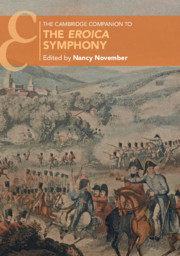Book contents
- The Cambridge Companion to the Eroica Symphony
- Cambridge Companions to Music
- The Cambridge Companion to the Eroica Symphony
- Copyright page
- Contents
- Illustrations
- Musical Examples
- Notes on Contributors
- Eroica Chronology, 1770–2020
- Acknowledgements
- Introduction
- Part I Context and Genesis
- Part II Analytical Approaches
- 5 Twentieth-Century Analytical Approaches to the First Movement
- 6 The Hero Who Practices Resignation: Beethoven’s Eroica as ‘Late’ Work
- 7 Registering the Eroica
- 8 After Invention: Traces and Materials in the Eroica Finale
- Part III Reception
- Further Reading
- General Index
8 - After Invention: Traces and Materials in the Eroica Finale
from Part II - Analytical Approaches
Published online by Cambridge University Press: 04 June 2020
- The Cambridge Companion to the Eroica Symphony
- Cambridge Companions to Music
- The Cambridge Companion to the Eroica Symphony
- Copyright page
- Contents
- Illustrations
- Musical Examples
- Notes on Contributors
- Eroica Chronology, 1770–2020
- Acknowledgements
- Introduction
- Part I Context and Genesis
- Part II Analytical Approaches
- 5 Twentieth-Century Analytical Approaches to the First Movement
- 6 The Hero Who Practices Resignation: Beethoven’s Eroica as ‘Late’ Work
- 7 Registering the Eroica
- 8 After Invention: Traces and Materials in the Eroica Finale
- Part III Reception
- Further Reading
- General Index
Summary
The Eroica finale is its most contested movement. It is at once Beethoven’s earliest unique structure, departing from any known formal precedent, and the only piece he based on his own earlier compositions. The theme comes from his ‘heroic-allegorical’ or ‘allegorical-historical’ ballet, The Creatures of Prometheus, Op. 43, first performed in March 1801. The following year he wrote the Variations for piano in E♭ major, Op. 35, on that theme, and sought to have the title page identify the theme’s source as his ‘allegorical ballet Prometheus’.1 And, as Lewis Lockwood has shown, immediately upon completion of the variations Beethoven sketched out a movement-plan for a symphony in E♭ major, the projected finale of which is inferably to be based on Op. 35.2 It seems to have been the theme and its variations, then, that formed part of the ‘invariant concept’ of the symphony, in Lockwood’s words.3 What was it about this theme that drew Beethoven to compose with it after its invention was complete, to start to elaborate it anew, and in such different genres?4 This chapter seeks to explore the traces of these earlier works in the Eroica and to consider which of them Beethoven found essential to his symphonic conception. In particular, it will bring together his letters concerned with the counting of variations in Op. 35 and a sketch page suggesting that the theme of the Eroica finale will be ‘varied and deduced’, which have not yet made an impression on analytical understandings of the movement. Ultimately, these material traces will be used to illuminate the intersection between variation form and symphonic discourse.
- Type
- Chapter
- Information
- The Cambridge Companion to the Eroica Symphony , pp. 157 - 180Publisher: Cambridge University PressPrint publication year: 2020



